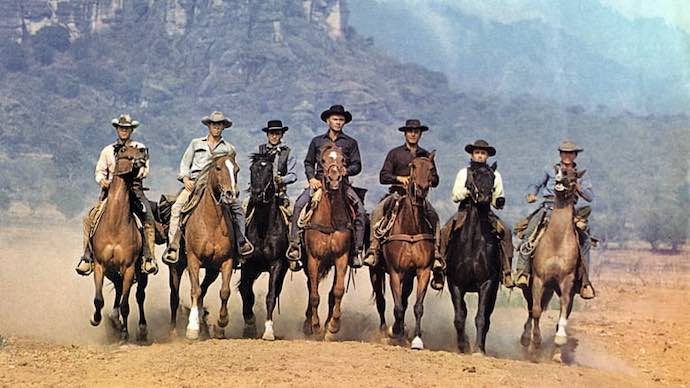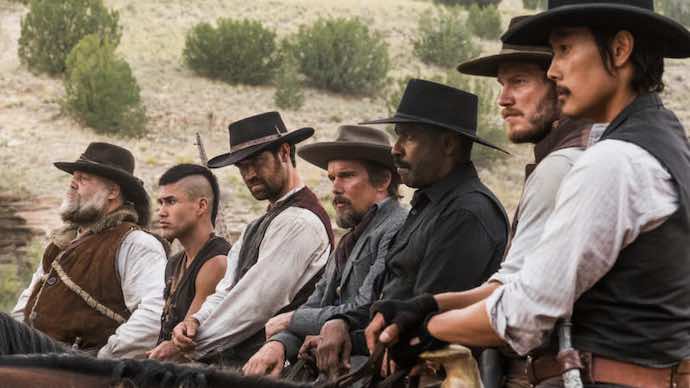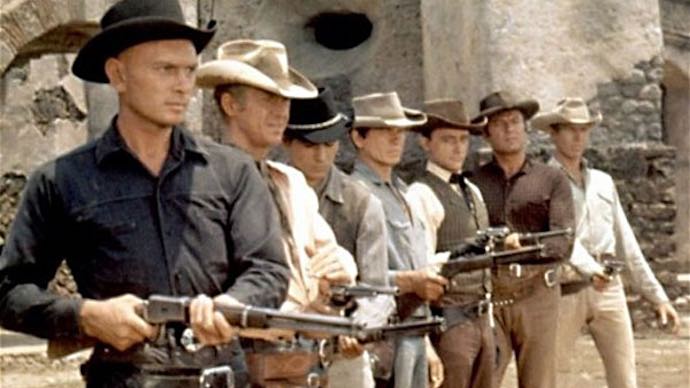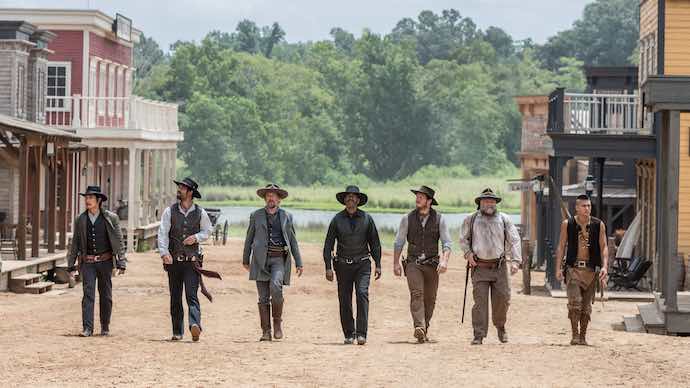The 1960 classic Western remake of Akira Kurosawa’s Seven Samurai achieved something that most loose remakes fail to do: become famous in their own right. And that’s why Denzel Washington and Antoine Fuqua teamed up to remake the 1960 remake in 2016. Like the original cast, the 2016 edition of The Magnificent Seven also went big with its members of the eponymous seven. Alongside Denzel Washington, we saw the likes of Ethan Hawke, Chris Pratt, and Vincent D’Onofrio protecting the townsfolk from threatening bandits. But is this another case where the remake bettered the original? Here’s our comparison of both 1960 and 2016 versions of The Magnificent Seven to see which one comes out on top.
1. Writing, Compared
Both the 1960 original and the 2016 remake follow the same general story that was put forward by Akira Kurosawa’s Seven Samurai—a town full of innocent villagers need help because a gang of bandits keep pillaging their homes for goods and supplies. The 2016 version of The Magnificent Seven does deviate slightly in some areas, but in the end, the overall plots are pretty close to identical. What exactly is different? Well, the 2016 remake is noticeably broader in scope and aims to give a proper backstory to the villain (played by Peter Sarsgaard) while turning the townsfolk into real characters rather than mere “people of the village” as they were in the 1960 original. As far as dialogue, the original and the remake both do a stellar job of showcasing The Seven and the complex dynamics within the group. However, while the original feels more like an earnest attempt to be as great as Seven Samurai, the 2016 version has more fun with itself. Moreover, the 1960 original relies heavily on Eli Wallach’s Calvera—leader of the bandits—for its villainy because the film focused so much on McQueen, Brynner, Bronson, and Coburn as to push out most of the other characters from the story. But hey, Wallach’s performance was superb. Indeed, the biggest strength of the 1960 original is its leading actors, all of whom delivered blistering performances. To put it succinctly, the 2016 remake was an attempt to flesh out the story, but the 1960 original has a hold that the remake fails to capture—and the sheer effort put into the original The Magnificent Seven makes it a far grittier picture overall.
2. Cast & Performances, Compared
The ensemble casts in both films are quite impressive. The 1960 original The Magnificent Seven starred Yul Brynner, Steve McQueen, James Coburn, Eli Wallach, and Charles Bronson. All of them were the biggest stars to appear collectively for the era. The 2016 remake The Magnificent Seven starred Denzel Washington, Ethan Hawke, Peter Sarsgaard, Vincent D’Onofrio, and Chris Pratt—and even roped in South Korean film star Lee Byung-hun. Yul Brynner and Denzel Washington lead their respective groups, and the characters are more or less straight copies of each other (despite having different names). Chris Pratt is Steve McQueen’s character, Ethan Hawke is Robert Vaughn’s equal, etc. But the actual portrayals of each character are very different. Ethan Hawke stands out in particular with a markedly unique performance, even if his overall mandate is broadly similar to Robert Vaughn’s. The same is true of the wider cast, who are all given deeper characters and more interesting dialogue to play with, which was sorely lacking in the original film (and resulted in limited performances from non-stars). So while the 1960 original had a more potent leading cast, the 2016 remake brought out stronger all-around performances from everyone.
3. Action Sequences, Compared
On one hand, comparing the action sequences between a film from 1960 and a film from 2016 can be unfair. Obviously the latter film will benefit from advancements in visual effects, filmmaking techniques, and everything else that changed in the decades between. Simply put, the 1960 original looks and feels like a classic Western while the 2016 remake has wonderfully choreographed sequences with heavy casualties, with several members of The Seven meeting their doom at the hands of the bandits. That said, the 1960 original does have its own charm. It relied on the gravity of its actors to showcase a finale that had more thematic intensity. Watching the remaining members of The Seven leave town is a shot that perfectly evokes Seven Samurai. Objectively, the 2016 remake is better when it comes to action. The set pieces are thrilling and fun to watch, breaking away from the tropes of the original and turning out a more modern experience.
4. Direction, Compared
Hollywood icon John Sturgess directed the original The Magnificent Seven while growing name Antoine Fuqua helmed the 2016 remake. Both directors did their jobs well. Antoine Fuqua had a strong command of his expansive cast and was able to mold fun performances from them, lending them a chance to shine around his incarnation of The Seven. He’d worked with many of them before and they all generally got on well. John Sturgess faced a much steeper battle. Constant arguments between Yul Brynner and Steve McQueen led to discord and disruption. The pair famously didn’t get along, with McQueen reportedly taking opportunities to upstage Brynner and Brynner attempting to outdo McQueen. Despite this, Sturgess had a clearer idea of how he wanted his film to come across. He might have limited the supporting characters and cast, but he was able to draw out towering lead performances that made the audience not care to see more of the rest. And that’s why the 1960 original worked so well: the strength of The Seven was more important than balancing the cast. In the end, even though the 2016 remake has a unique charm that makes it worth watching, the 1960 original remains the better film. Not only does it stand up on its own merits, it remains a classic to this day. Read next: The best movies made by black directors and filmmakers






